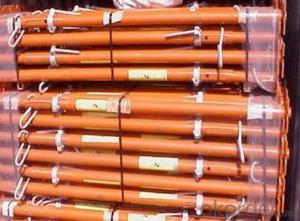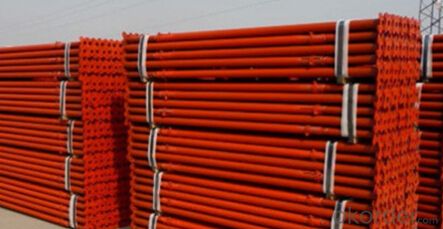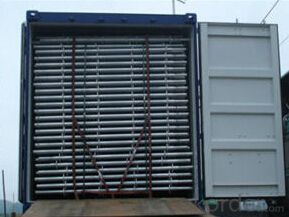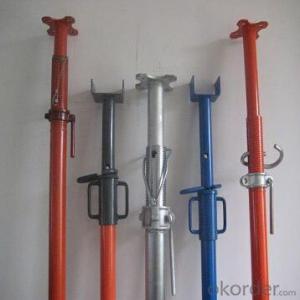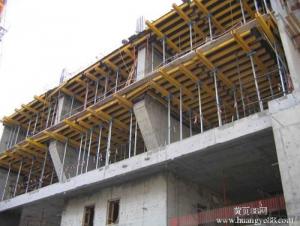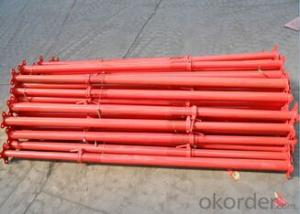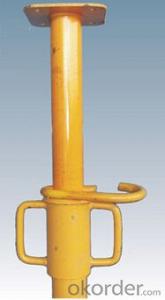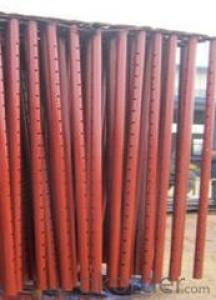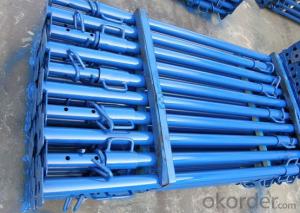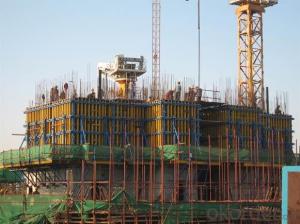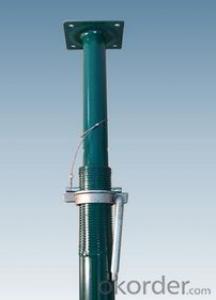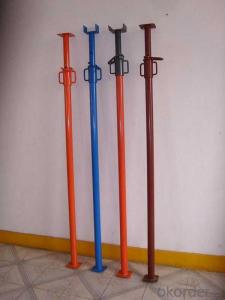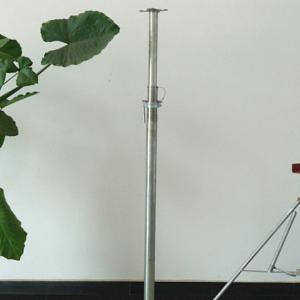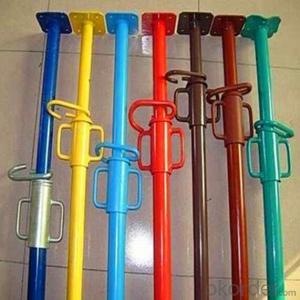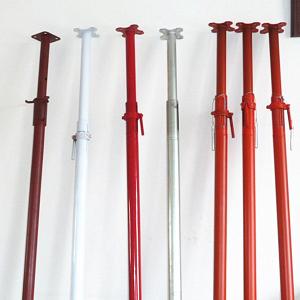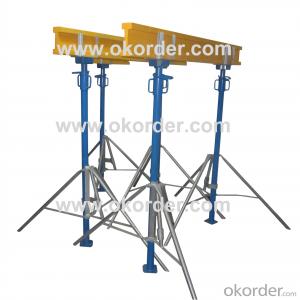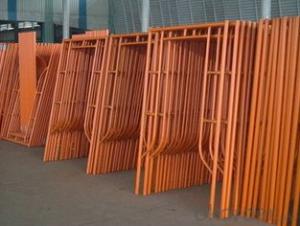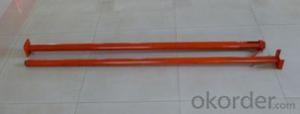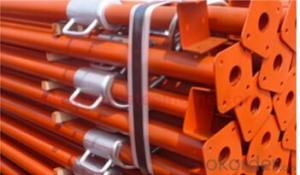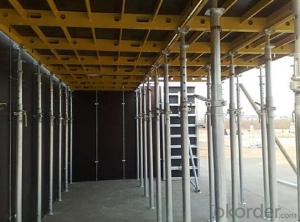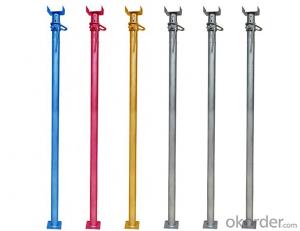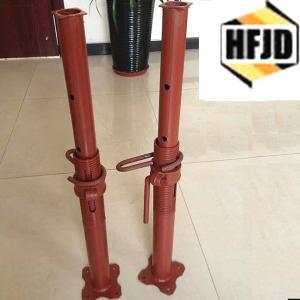Adjustable Steel Formwork scaffold Shoring Prop
- Loading Port:
- China Main Port
- Payment Terms:
- TT OR LC
- Min Order Qty:
- -
- Supply Capability:
- -
OKorder Service Pledge
OKorder Financial Service
You Might Also Like
Quick Details
| Type: | Adjustable range: | outer&inner tube size: | |||
| outer&inner tube thickness: | prop sleeve/nut: | base plate: | |||
| bearing capacity: |
Packaging & Delivery
| Packaging Detail: | shoring prop for scaffolding:in steel pallets or as required |
| Delivery Detail: | shoring prop for scaffolding:15-20 days |
Specifications
Adjustable Steel Formwork Shoring Prop
1.material:Q235
2 surface:painting /powder coating /zinc plate
3 weight:customized
Adjustable Steel Formwork Shoring Prop
1.Material:Q235
2.Size:as you want
3.Type:formwork system
4.Surface treament:hot-dip galvanized.dip-painting,electroplate galvanized, power coating
1. Product details:
Item no. | SD-4001 |
Scaffolding Part Type | Prop shoring |
Item name | Adjustable Steel Formwork Shoring Prop |
Material | Q235 |
Surface | painting /powder coating /zinc plate |
Type | scaffolding system |
Application | scaffolding formwork |
2. Our Services and products:
(1) Scaffolding System:Including Ringlock Scaffolding System and accessories; Cuplock Scaffolding System and accessories; Kwikstage Scaffolding System and accessories; Haki Scaffolding System and accessories;
(2) Scaffolding Frame & Accessories:Including Walk Through Frame Scaffolding; Ladder Frame Scaffolding; Accessories; we also can make scaffolding according to your samples or drawings.
(3) Scaffolding Couplers/Clamps:We can produce all kinds of forged and pressed couplers, including British type couplers, American type couplers, German type couplers, Italian type couplers ,fence couplers, BRC coplers and so on. We also can produce according to your drawings or samples.
(4) Formwork System Scaffolding & Accessories:Light Duty Shoring prop and Heavy Duty Shoring Prop; Wing nuts and Tie rods; RASTO clamp and so on.
- Q: What are the potential ergonomics concerns when using steel props?
- The potential ergonomics concerns when using steel props include the weight and handling of the props, which may lead to physical strain and fatigue for workers. Additionally, improper positioning or adjustment of the props can result in awkward body postures, increasing the risk of musculoskeletal injuries.
- Q: Are steel props suitable for supporting temporary roofs?
- Yes, steel props are suitable for supporting temporary roofs. Steel props are strong, durable, and adjustable, making them ideal for providing reliable support to temporary roofing structures. They can efficiently bear the weight of the roof and can be easily adjusted to different heights, ensuring stability and safety during construction or repair projects.
- Q: How do steel props contribute to the prevention of concrete slab deflection?
- Steel props, also known as steel shoring or shore props, play a crucial role in preventing concrete slab deflection. These props are adjustable steel tubes that are used to support and reinforce concrete slabs during construction or renovation projects. By providing vertical support to the slabs, steel props help distribute the load evenly, minimizing the chances of deflection or sagging. They bear the weight of the slab, preventing excessive bending or warping, and ensure that the slab remains level and structurally sound. Additionally, steel props can be easily adjusted to accommodate variations in slab height, enabling precise control over the levelness of the concrete surface. Overall, steel props contribute significantly to the prevention of concrete slab deflection by providing reliable and adjustable support, promoting structural integrity, and ensuring a durable and safe construction outcome.
- Q: Can steel props be used for supporting temporary bridges during emergencies?
- Indeed, steel props have the capability to support temporary bridges in emergency scenarios. Their robustness and longevity make them an ideal option for offering provisional assistance to bridges during critical situations. They possess the ability to effectively bear the bridge's weight and guarantee its stability until a permanent resolution can be implemented. Furthermore, steel props are adjustable, facilitating effortless installation and customization to meet the specific demands of the bridge. Moreover, steel props are readily accessible and extensively utilized in construction, rendering them a pragmatic selection for emergency bridge support.
- Q: Can steel props be used for supporting temporary retaining walls?
- Yes, steel props can be used for supporting temporary retaining walls. Steel props are commonly used in construction projects to provide temporary support to structures. They are adjustable and have a high load-bearing capacity, making them suitable for supporting retaining walls. The steel props can be installed at regular intervals along the length of the retaining wall to provide additional stability and prevent any potential collapse. Additionally, steel props can be easily adjusted to accommodate changes in ground conditions or to provide additional support as the retaining wall is being constructed. Overall, steel props are a reliable and effective solution for supporting temporary retaining walls.
- Q: Are steel props adjustable in both inclination and declination?
- Steel props, also referred to as steel shores or steel acrow props, do not possess adjustability in both inclination and declination. These vertical supports are frequently utilized in construction for providing temporary support to structures during renovation or construction processes. Primarily engineered to be adjustable in height, they facilitate effortless adaptation to varying levels or heights. Nevertheless, their design does not include provisions for adjusting inclination or declination. Any attempt to modify their inclination or declination would jeopardize their stability and structural integrity, as their principal function is to provide vertical support.
- Q: Can steel props be used in temporary support for roof structures?
- Yes, steel props can be used in temporary support for roof structures. Steel props are commonly used in construction to provide temporary support and stability to various structures, including roofs. They are adjustable and can withstand heavy loads, making them suitable for temporary use during roofing projects or repairs.
- Q: Are steel props suitable for supporting temporary tents?
- Yes, steel props are suitable for supporting temporary tents. Steel props provide strong and sturdy support, making them ideal for holding up temporary tents and ensuring the safety and stability of the structure.
- Q: What are the main factors to consider when choosing the right steel props for a project?
- When choosing the right steel props for a project, there are several main factors to consider. Firstly, the load capacity of the props is crucial, as it should be able to support the weight of the structure or materials being propped. Additionally, the height and adjustability of the props should be considered to ensure they can be properly positioned and modified as needed. The material and construction quality of the props should also be evaluated for durability and safety. Lastly, it is important to consider the specific requirements of the project, such as the type of structure, environmental conditions, and any additional features or accessories needed.
- Q: What are the maximum and minimum heights available for steel props?
- The manufacturer and specific model of the steel prop can cause variations in the available maximum and minimum heights. Generally, steel props have a maximum height range of approximately 2.5 to 5 meters (8 to 16 feet) and a minimum height range of around 1 to 2 meters (3 to 6 feet). These heights are frequently utilized in construction and formwork scenarios to provide temporary support and uphold structures during construction or renovation undertakings. To ascertain the precise maximum and minimum height capabilities of a particular steel prop model, it is crucial to refer to the manufacturer's specifications and guidelines.
Send your message to us
Adjustable Steel Formwork scaffold Shoring Prop
- Loading Port:
- China Main Port
- Payment Terms:
- TT OR LC
- Min Order Qty:
- -
- Supply Capability:
- -
OKorder Service Pledge
OKorder Financial Service
Similar products
Hot products
Hot Searches
Related keywords
